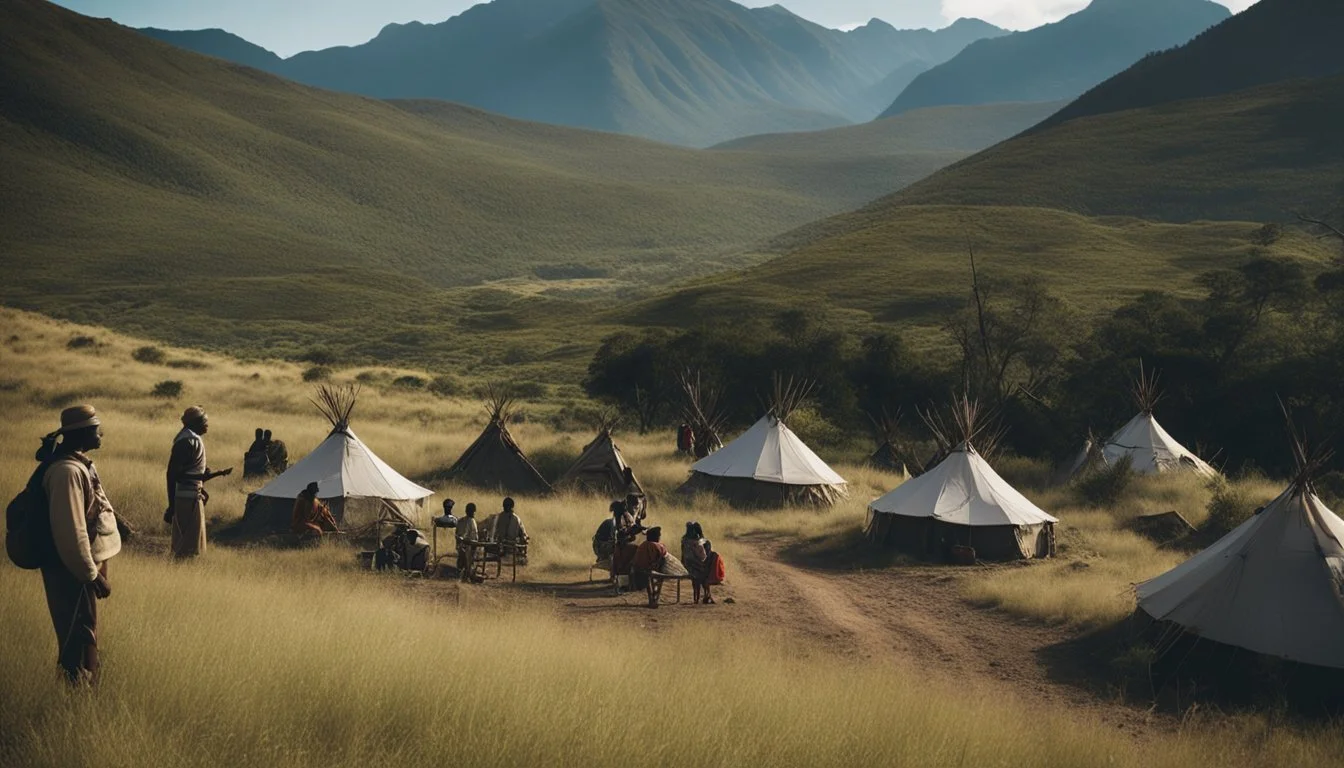Robert J. Flaherty: Pioneering the Art of Ethnographic Filmmaking's Impact on Cinema History
Robert J. Flaherty stands as a monumental figure in the realm of ethnographic filmmaking, often hailed as the father of the documentary film. Born on February 16, 1884, in Iron Mountain, Michigan, Flaherty's career reached its zenith with the release of "Nanook of the North" in 1922. This groundbreaking film not only showcased his innovative approach to capturing the lives of Indigenous peoples but also set a new standard for storytelling in the documentary genre.
Flaherty's work did more than merely document—it brought a sense of drama and narrative to real-life events, a technique that was revolutionary at the time. By staging certain scenes and casting Indigenous people as if they were professional actors, he transformed ethnographic subjects into compelling cinema. This method sparked much discussion but undeniably opened the door to endless possibilities in both fictional and non-fictional filmmaking.
The Harvard Film Archive acknowledges his fearless ventures as pivotal moments that enriched both fictional and ethnographic filmmaking. His influence persists, inspiring filmmakers to blend artistic creativity with authentic cultural representation.
Life and Legacy of Robert J. Flaherty
Robert J. Flaherty was born on February 16, 1884, in Iron Mountain, Michigan. He began his career as an explorer, which significantly influenced his ethnographic filmmaking.
Flaherty directed Nanook of the North (1922), often considered the first commercially successful feature-length documentary. This film made a lasting impact on documentary filmmaking, blending narrative elements with real-life settings.
Throughout his career, he produced and directed several other notable works, including Moana (1926) and Man of Aran (1934). These films further cemented his status as a pioneering figure in ethnographic and documentary cinema.
Flaherty's reputation was a blend of admiration for his innovative techniques and criticism for his methods. Some viewed him as a mythic figure in film, while others criticized him for lack of authenticity and social consciousness.
Despite mixed perceptions, his legacy as the "father of the documentary film" remains strong. His fearless ventures into documenting different cultures and ways of life opened new avenues in both fictional and ethnographic filmmaking.
Flaherty's style emphasized visual storytelling and the human element within various cultural contexts. His commitment to immersive filmmaking inspired future generations of documentarians to explore and portray real-life stories with sensitivity and depth.
He passed away on July 23, 1951, in Dummerston, Vermont, leaving behind a body of work that continues to influence and inspire the documentary genre.
Key Films:
Title Year Nanook of the North 1922 Moana 1926 Man of Aran 1934
Flaherty's films remain essential viewing for those interested in the origins and development of documentary storytelling.
The Emergence of Ethnographic Filmmaking
The early 20th century saw the birth of ethnographic filmmaking—a unique blend of visual storytelling and anthropological study. This genre aimed to document and represent the lives, cultures, and traditions of indigenous and remote communities through the lens of a filmmaker.
Robert J. Flaherty stands out as a foundational figure. His 1922 film Nanook of the North is often regarded as a pioneering work. Flaherty's approach was innovative for its time and set the groundwork for subsequent ethnographic films.
While using dramatized sequences, Flaherty gave audiences a glimpse into the Inuit way of life. His work blurred the lines between mere observation and genuine engagement with his subjects.
Flaherty's technique was to combine narrative film elements with the factual recording of daily activities. This integration brought a humanistic and relatable approach to ethnographic subjects, which was previously unseen.
Key Features of Early Ethnographic Films:
Authenticity: Striving to portray the real lives and practices of people.
Narrative: Incorporating storytelling elements to make the subject more engaging.
Cultural Insight: Providing viewers with an understanding of diverse social norms and rituals.
Ethnographic filmmaking evolved further post-World War II. Influential filmmakers like Jean Rouch and John Marshall expanded on Flaherty’s initial methodologies. They embraced more immersive and participatory techniques.
Flaherty’s legacy is evident in the way ethnographic films continue to provide profound insights into the human condition. His work remains a benchmark in the study and appreciation of different cultures through film.
Major Works by Robert J. Flaherty
Robert J. Flaherty was a renowned filmmaker whose documentaries were pivotal in the development of ethnographic filmmaking. His most significant works include "Nanook of the North," "Moana," "Man of Aran," and "Louisiana Story."
Nanook of the North: A Story of Life and Love in the Actual Arctic
"Nanook of the North" (1922) is widely considered the first feature-length documentary. It focuses on the life of an Inuit family in the Canadian Arctic. Flaherty followed the family led by Nanook, capturing their daily struggles and survival tactics. The film's compelling narrative and visual style brought realistic depictions of Inuit life to a global audience. It remains a groundbreaking work in documentary filmmaking.
Moana: A Romance of the Golden Age
"Moana" (1926) takes place in Samoa and aimed to depict the cultural practices of Samoan life. Unlike "Nanook," it emphasizes the romantic and peaceful aspects of traditional Samoan society. Flaherty's use of natural lighting and detailed focus on customs like tattooing added narrative depth. The film pioneered what Flaherty called a "documentary drama," blending reality with staged elements to enhance storytelling.
Man of Aran: Capturing the Struggle
"Man of Aran" (1934) explores the harsh conditions faced by inhabitants of the Aran Islands off the west coast of Ireland. The film captures the ceaseless struggle of the Islanders against the unforgiving natural elements. Flaherty features traditional activities such as fishing and farming against a backdrop of crashing waves and rugged landscapes. The film is noted for its stark portrayal of human endurance and resilience.
Louisiana Story: The American South
Released in 1948, "Louisiana Story" portrays the impact of oil drilling in the Louisiana bayous through the eyes of a young boy. Unlike his earlier works, this film had some sponsorship from Standard Oil. Flaherty still managed to weave a compelling narrative that combines the natural world with the encroaching industrial landscape. His keen eye for detail and ability to tell a human story through visual means made this film memorable.
Innovative Techniques and Cinematic Innovations
Robert J. Flaherty introduced several groundbreaking techniques that transformed documentary filmmaking. His contributions include blending fact and fiction, shooting on location, and using non-professional actors to bring authenticity to the screen.
Unscripted Narrative: Blending Fact and Fiction
Flaherty pioneered the use of unscripted narratives, merging reality with storytelling. In "Nanook of the North" (1922), he portrayed the life of the Inuit people, blending real events with staged scenes to enhance the narrative.
This innovative approach allowed him to create engaging stories that felt authentic while maintaining a cinematic quality. By focusing on the human element, Flaherty's films blurred the line between documentary and fiction, setting a benchmark for future ethnographic filmmakers.
On Location Shooting: Embracing Natural Settings
Flaherty was one of the first filmmakers to embrace on-location shooting to capture the true essence of his subjects. By filming in actual environments rather than constructed sets, he brought a sense of realism and immersion to his documentaries.
For instance, "Man of Aran" (1934) was filmed on the Aran Islands, beautifully showcasing the rugged landscape and the harsh realities of the islanders' lives. This commitment to on-location shooting helped elevate the visual and emotional impact of his work.
Non-Professional Actors: Authenticity on Screen
Flaherty's choice to use non-professional actors was a deliberate effort to enhance the authenticity of his films. He cast real people from the communities he was documenting, rather than trained actors, to stay true to their everyday lives and experiences.
In "Moana" (1926), he worked with Samoan villagers, enabling the film to portray genuine cultural practices and traditions. This technique provided a raw and honest portrayal of his subjects, making his work resonate deeply with audiences and critics alike.
By integrating these innovative techniques, Robert J. Flaherty not only pioneered a new form of documentary filmmaking but also set a high standard for future filmmakers in the ethnographic genre.
Ethical Considerations in Ethnographic Storytelling
Ethnographic storytelling raises significant ethical questions. Filmmakers must navigate the balance between authenticity and respect for their subjects. Ensuring the dignity and privacy of individuals depicted in these films is paramount.
Informed consent is a critical ethical principle. Subjects should fully understand how their images and stories will be used. They must have the agency to withdraw participation at any time.
Additionally, filmmakers must avoid reinforcing stereotypes. Presenting communities in a biased or prejudiced manner can perpetuate harmful misconceptions. It is essential to portray the complexities and diversities within cultures accurately.
Transparency in the filmmaking process is crucial. This includes being honest about the intentions behind the project and the potential impacts on the communities involved.
Ethical storytelling also involves collaboration with the subjects. Involving the community in the filmmaking process can lead to more authentic and respectful representations.
Filmmakers should be accountable for how the films are used and distributed. It is important that the films do not exploit the subjects for commercial or personal gain.
Lastly, the context of the film must be considered. Depicting cultural practices without providing appropriate context can lead to misinterpretation and misunderstanding among audiences.
By adhering to these ethical considerations, filmmakers can create more responsible and respectful ethnographic films that honor the subjects and their cultures.
Collaborative Relationships and Influence
Robert J. Flaherty's career was marked by significant collaborative relationships. He worked closely with his subjects, often living among them to gain insight into their daily lives. This unique approach allowed him to build trust and capture authentic moments on film.
Key Collaborations:
Frances Hubbard Flaherty: His wife played a crucial role, contributing to the scripts and editing of his films.
Indigenous Communities: Particularly for Nanook of the North, Flaherty's collaboration with the Inuit people was fundamental. He involved them in the filmmaking process, though he did stage certain scenes for dramatic effect.
Influence on Peers:
Flaherty's methods had a lasting impact on ethnographic filmmaking. His blending of reality and staged scenes created a new genre. Many filmmakers adopted his immersive approach, valuing collaboration with subjects to enhance authenticity.
By fostering these relationships, Flaherty not only influenced the content of his films but also set a precedent for future documentary makers. His approach emphasized the importance of mutual respect and cultural sensitivity in filmmaking.
Criticism and Controversy
Robert J. Flaherty's work has been subject to significant debate regarding the authenticity of his films, the representation of indigenous voices, and the balance between cinematic impact and ethnographic integrity.
Debate Over Staged Authenticity
Flaherty has been criticized for staging several scenes in Nanook of the North to create a more compelling narrative. Critics argue that by directing Inuit participants as though they were actors, Flaherty blurred the line between documentary and fiction.
He instructed his subjects to perform traditional activities that were no longer part of their daily lives.
This raises ethical questions about the authenticity and documentary value of his work.
Representation and the Indigenous Voice
Another major criticism regards how Flaherty represented indigenous peoples. Flaherty's films often showcased his subjects through a colonial lens, framing them in ways that played into stereotypes. Critics from the anthropological community argue that Nanook of the North lacks the direct voice of its Inuit subjects.
By not incorporating their perspectives or allowing them to narrate their own stories, Flaherty presented a limited view of their culture.
Cinematic Impact versus Ethnographic Integrity
While Nanook of the North is praised for its groundbreaking visual storytelling, its ethnographic accuracy has been questioned. Flaherty's emphasis on creating an engaging film sometimes came at the expense of factual representation. His decision to dramatize realities for narrative effect leads to distorted perceptions of Inuit life.
This tension between cinematic artistry and ethnographic truth remains a contested aspect of his legacy.
The Legacy of Flaherty's Techniques in Modern Filmmaking
Robert J. Flaherty's impact on modern filmmaking is profound. His pioneering work laid the foundation for contemporary documentary practices.
Flaherty's technique of blending fiction and reality remains prominent. By staging scenes for dramatic effect, he blurred the line between nonfiction and fiction, a method seen in docudramas today.
Ethnographic Influences:
His ethnographic style influenced filmmakers to focus on cultural narratives.
Modern global documentaries draw from his immersive approach.
Stylistic Choices:
Use of non-professional actors continues in modern cinema.
Handheld camera work, showcased in films like Nanook of the North, inspired the cinéma vérité movement.
Innovative Narratives:
Flaherty’s storytelling techniques encouraged filmmakers to prioritize compelling narratives.
The dramatization of real-life events finds roots in his methods.
Notable Adaptations
Technique Modern Example Staging Scenes The Act of Killing Ethnographic Focus Paris is Burning Non-professional Cast City of God Handheld Cameras The Blair Witch Project
Flaherty's fearless approach to filmmaking encouraged a more intimate and authentic portrayal of subjects, a key aspect of modern documentaries. His legacy continues to influence both the documentary genre and broader cinematic practices.
Concluding Remarks on Robert J. Flaherty’s Influence
Robert J. Flaherty’s contributions to documentary filmmaking are indelible.
Through works like Nanook of the North and Moana, he laid the groundwork for ethnographic film.
Flaherty's approach combined visual storytelling with ethnographic study, influencing filmmakers who followed.
Despite controversies regarding the blending of fiction and nonfiction, his innovative techniques remain influential.
Flaherty’s films continue to be studied for their pioneering methods and impact on the genre.
His unique vision advanced the art of documentary filmmaking, making a lasting imprint on the field.



